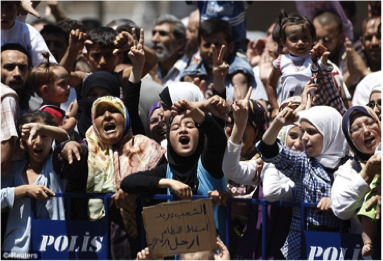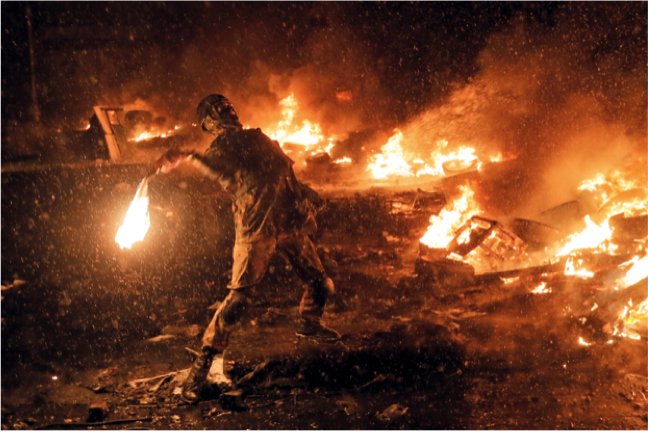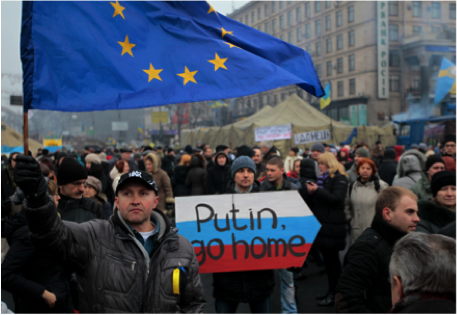By Rachael Andrews
In 2011, the highly coveted Time Person of the Year moniker went not to a single person, but to a figure that embodied the millions of people who affected change in the world more than anyone else: the protester. Despite Francis Fukuyama’s proclamation of the “End of History,” referring to the “end point… of ideological evolution,” as a result of increasing complacency and apathy among the citizens of the world, particularly the younger “millennial” generation, the 2010s have seen an increase in protests around the world. Protests are perhaps the most divisive tool in the citizen’s toolbox, made even more divisive by a government’s sometimes unpredictable responses. The protests of Syria in 2011 and Ukraine in 2014 are the most relevant examples of how the governments of Syria and Ukraine – and by proxy, Russia – gravely mishandled the situations, committing crimes against their own people and doing a disservice to civilian participation, as the protests turned violent.

Recognizing the differences between the Syrian and Ukrainian uprisings is crucial, because one cannot discuss them without touching upon the context of each. The Syrian protests began in response to the kidnappings of dissenters by the Ba’athist Assad regime and as a part of the Arab Spring, a massive wave of demonstrations across the Arab World that resulted in unrest and lawlessness in much of the Middle East. The Ukrainian protests, led largely by students, came in response to President Viktor Yanukovych’s refusal to sign an agreement with the European Union despite his earlier promises to abide by the wishes of his people. Both the Syrian and Ukrainian governments chose to respond to the peaceful protests with brutal – often deadly – force.
These two events share a key similarity: the response of the respective governments. What began as peaceful movements demonstrating declining trust in the state ended in two bitter civil wars and the decline of the states themselves. After the governments’ heinous reactions to the demonstrations, the conflicts turned violent as citizens’ human rights were continuously violated.

One difference worth noting is that the Ukrainian protests did in fact result in change: Yanukovych was ousted, new elections were held, and the agreement with the EU was eventually signed. Yanukovych fled to Russia, the Ukrainian Parliament concluded that Yanukovych “withdrew from his duties in an unconstitutional manner,” and the country held new elections. Russia then annexed Crimea and backed pro-Russian separatists working to disturb the peace and overthrow the interim Ukrainian government, which had signed an agreement with the EU.
When protests go bad, they can take an entire political system down with them. What should be a democratic representation of civic participation can turn sour as soon as the government involved takes a wrong step. By shutting down protests with force, the governments are not saying that the protesters are wrong, but that they are afraid of what the protesters are saying. Responding with brutality is a sign of weakness on behalf of the government. Often, as in the cases of Syria and Ukraine, censorship is also used as a form of crackdown after a major demonstration. Needless to say, responding to a peaceful display of discontent with severe punishments can serve to worsen the consequential violence of the protests rather than to alleviate it.
Protests have become a favorite tool among not only the young, but also the middle-class and educated. In some cases, the are the only real tool available. The 2010s have seen a rise in the act of protesting and civic mobilization, a phenomenon that can be accredited, at least in part, to social media. For instance, in Ukraine, protesters relied more heavily on news from social media concerning the demonstrations (their locations, purposes, casualties, etc.) rather than mainstream outlets.

Governments can choose to use protests as a tool for a more representative government, quell the concerns of the people without resorting to violence, or employ a targeted form of repression that also does not require mass violence. The problem is, they rarely choose any of these options – or at least, they find themselves incapable of doing so. Especially in countries where democracy is relatively new, protests are often seen as a threat directed at the government by the people. Instead of listening to or serving the citizens, or refusing to use violence against their citizens, the Yanukovych and Assad administrations opted to abandon their civic duty, resulting in civil conflict. Of course, looking back from where we are now, it is easy to say that perhaps the protests were a warning to the governments of Ukraine and Syria from the protesters that the current path will lead to destruction and chaos. Both conflicts now symbolize the lengths that powerful regimes will go to in order to protect their own power and interests over those of their citizens.
Defenders of these administrations may say that these protesters do not embody the will of the citizens, accusing them of being backed by foreign governments and fascists instead. However, by and large, these protesters are not calling for fascist ideologies to take over the government, but rather asserting that the government no longer accurately represents what the people want. Yes, Yanukovych was elected in a free, fair, internationally monitored election. But he was also elected on a platform that would arguably lead to closer ties with the EU, then reneged on this pledge after getting into office and meeting with Russia. The protests represent the anger that some citizens felt at Yanukovych’s broken promises. Similarly, in Syria, there may not have been many democratic institutions in place to facilitate peaceful protests leading to policy change, but the citizens do have a right not to be tortured and assaulted by their government, no matter the regime type.

The art of handling a protest is hardly a perfected one. Advanced democracies like the United States and Canada have had their own issues with properly handling peaceful demonstrations in recent years. What is the government to do when protesters call their policies into question? There is no clear answer other than “do not fight back; do not harm the people.” It will not only add fuel to the fire, but also go against the moral obligation of the government to protect its citizens, even those who disagree. But this raises a new question: how can a government be expected to comply with the requests of the movement? What if the movement is wrong? Too often, governments answer these questions with brute force and violence.
There is no perfect policy for governments on how to conduct themselves during civil unrest. It is obviously desirable to keep the peace, but how? There is no one answer because each situation is different. Of course, many protests occur in places where democratic institutions are not the norm. Even when looking at demonstrations from a democratic standpoint, it is still in the best interest of the government to find a way to quell the protest without resorting to mass violence. When violence answers protests, Ukraine and Syria tell us that civil conflict may not be long after.
If these are the fruits of the protest today, then what is its place in civil society? Does the symbolism of the protest justify the possible violence that will follow at the behest of the regime in power? Or should we expect the people to follow quietly and obediently a government that no longer represents the public’s best interests? From Tunisia, to Egypt, to Spain, to New York, to Oregon, to Ferguson, to Syria and Ukraine – all over the world, it would seem – citizens are giving answers.
